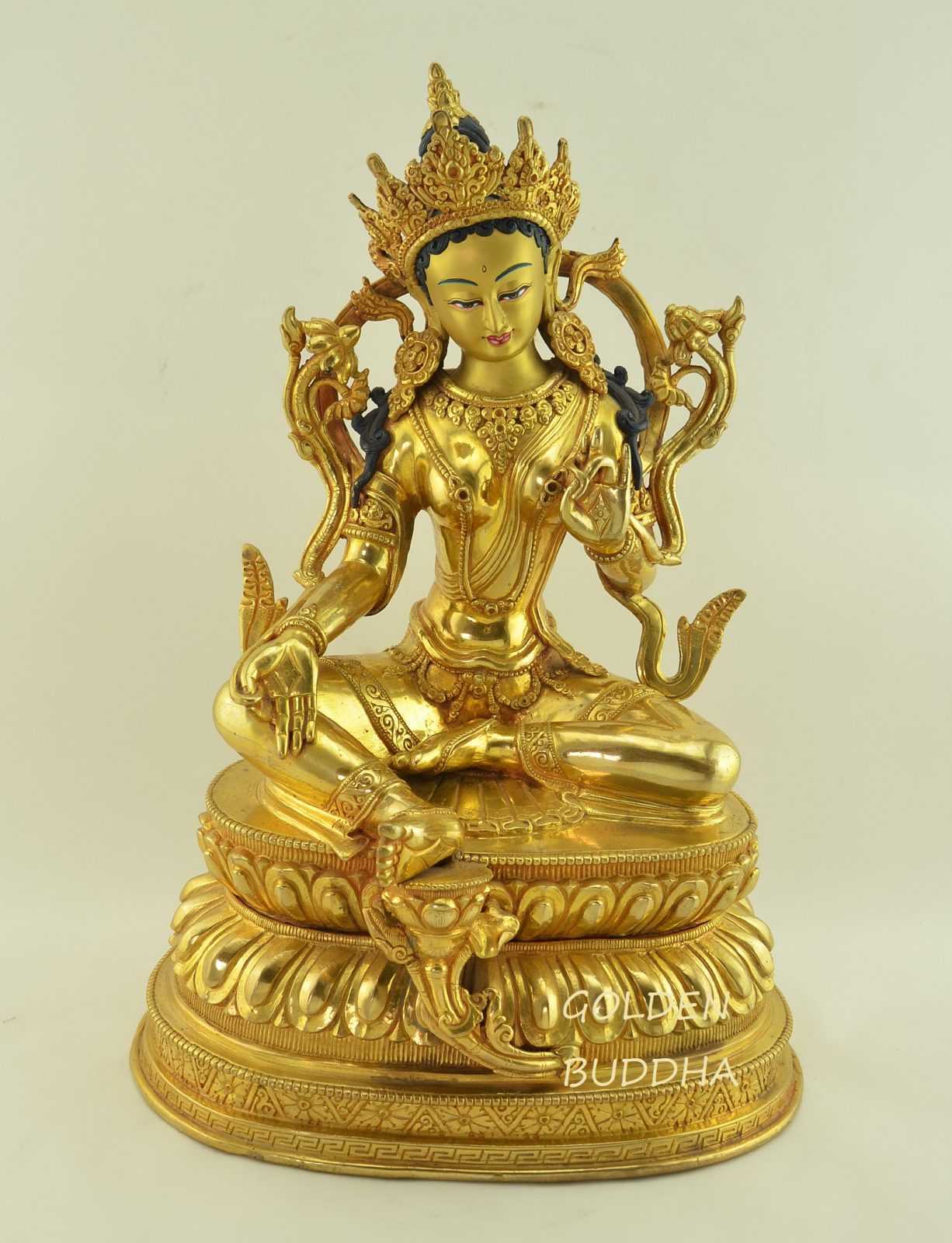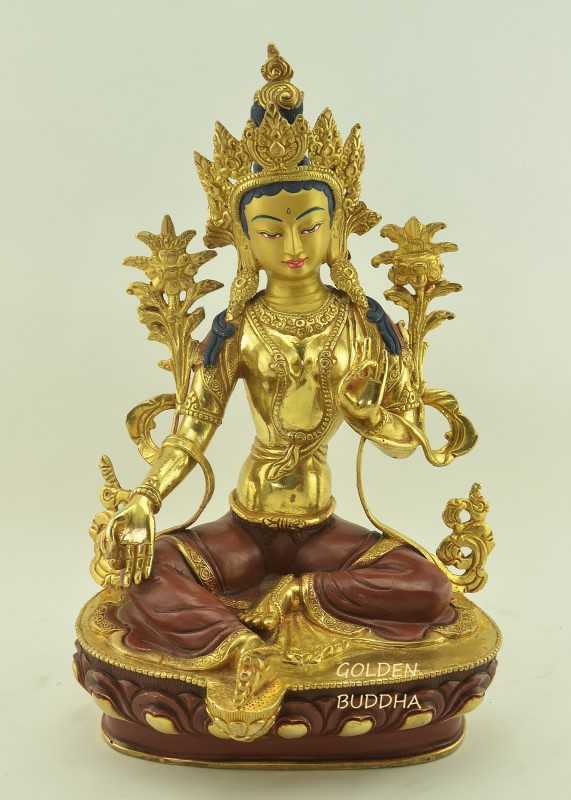The divine inspiration behind a statue of Tara is a renown Buddhist deity that first appeared in the “Prajnaparamita Sutra”. However, the Tara statue meaning found in the sutra was vague and mostly coincided with the rapidly evolving popularity of Mahayana Buddhism.
Eventually, about 5 centuries later, the essence of a Tara statue evolved to become expressed as the “compassion of perfected wisdom”. Indeed, the character and appearance of Tara statues would soon become much more elaborate.
Evolution of Tara Statues
The worship of Tara statues spread rapidly with the rise of the Pala Empire in 8th century India. As a result, worship of the Tara Goddess would take root in both Mahayana and the more progressive Tibetan Buddhism. Additionally, Tibetan Buddhism would play an important role in the evolution and growing popularity of the Tara statue meaning. It was in Tibet that the character and physical appearances of Tara would gain in complexity.
The cult of Tara would soon take root in other countries who adopted Tibetan Buddhism such as Nepal, Bhutan and Mongolia. Scholars believe that Tara’s Hindu origins enabled her acceptance in Buddhism. Indeed, the close affiliation of Hinduism and Buddhism results in the mutual acceptance of deities.

Tara’s Birth & Commitment to Feminism
In Tibetan Buddhism, Tara was born from a teardrop that fell from the eye of Avalokiteshvara. Tibetan Buddhists also believe that she is the female aspect and consort of Avalokiteshvara.
However, Tara is also fiercely independent and she is arguably the world’s first feminist. The Tara Bodhisattva vowed to refuse reincarnation as a male until there were more female Buddhas.
21 Variations of a Tara Statue
The complexity of Tara evolved into 21 variations which were based on the 21 verses taken from the “Praises of the 21 Taras”. However, disagreement exists between Tibetan Buddhist schools with matching each praise to each variation of Tara. Unfortunately, there is a difference of opinion but the Tara meanings are generally quite similar.
In fact, Tara represents an entire class of deities. Indeed, the 21 Taras protect devotees from the eight and also 16 fears. Additionally, 21 Taras allow followers to broadly address internal weaknesses hourly or daily according to their predisposition. Accordingly, the 21 Taras display various depictions including wrathful, semi-wrathful and peaceful.
“Khadiravani” Green Tara Statue
The most popular form of the 21 Taras is “Green Tara” or Khadiravaṇi. The color green reflects her attributes of speed and agility. Furthermore, Green Tara is a forest goddess who resides in her pure land called Mt Potala. Mt Potala is a lush evergreen paradise with waterfalls, birds, flowers and trees.
Khadiravani Statue

Symbolism of Green Tara Statues
Quickness of movement is an attribute of Green Tara and she is always ready to spring to action and relieve suffering. As a result, seated Green Tara statue Nepal shows her right leg extended and the left leg pulled in to reflect meditative contemplation.
Furthermore, Green Tara statues display the Abhaya mudra with the left hand, in contrast to other Buddhas who use the right hand with fingers straight up and palm flat. Our Green Tara statues depict her using “gift giving” Varada mudra with the right hand.
Symbolism of the Lotus Flower
The blue lotus flower (uptala) growing over each shoulder of Green Tara represents enlightenment. This is because the lotus grows from the muddy pond bottom to blossom in the clean air and sunshine on the surface of the pond. Metaphorically speaking, the lotus symbolizes the struggle of sentient life in the sea of samsara.
One of the lotus flowers remains closed to entice devotees to reach for the unopened rewards of Nirvana that awaits them. Additionally, the blue lotus flower has a special characteristic because it releases its fragrance at night with the moon. Therefore, Green Tara has become affiliated with the moon (similar to White Tara).
Green Tara Mantra Meaning
The English translation means “I prostrate to the Liberator, Mother of all the Victorious Ones.” “Mother of the Victorious ones” refers to the belief that Tara is the mother of the Tathagatas (Buddhas).
“oṃ tāre tuttāre ture svāhā”
Green Tara practice protects devotees from fear and the eight obscurations of pride, delusion, hatred, jealousy, wrong views, avarice, desire and deluded doubts. Indeed, Green Tara mantra miracles induce strength in devotees to overcome their fears and the above mentioned obscurations. As a result, the Green Tara mantra enables practitioners to assist others and ease their suffering.
“7-Eyed” White Tara Statue
White Tara devotees believe she glows with the radiance of a thousand full moons. Additionally, White Tara attributes include healing, longevity and compassion for all sentient life. Indeed, the compassion of White Tara for sentient beings even exceeds a mother’s love. Furthermore, White Tara statues feature her seven eyes.
White Tara Statue

Indeed, the seven eyes include an extra eye in the middle of her forehead, two on her face and one eye on each of her hands and feet. As a result, the White Tara’s actions are imbued with the compassion and wisdom of the Buddhas.
White Tara is the “Cintachakra” or the wish fulfilling wheel and she can grant faithful devotees anything they desire. Additionally, White Tara is one of the three deities of long life.
In contrast with Green Tara, a White Tara statue sits in full lotus or diamond pose. But on a similar note, White Tara statues display the same mudras as Green Tara. White Tara is also a Buddha in Tibetan Buddhism, however she is a Bodhisattva in Mahayana Buddhist beliefs.
White Tara Mantra
One common method of venerating White Tara is to recite her mantra. The White Tara mantra benefits will inspire devotees to defeat the defilements and overcome their resultant bad karma.
“Om Tare Tuttare Ture Mama Ayuh Punya Jñana Pustim Kuru Svaha”
Dancing Red Tara Statues – “Kurukulla”
Our statue of Tara selection includes a wrathful emanation of Dancing Red Tara. This deity is also known as “Kurukulla”, she is a deity of enchantment. As a result, her devotees believe that she can give them special powers of persuasion. Indeed, gratuitous recitation of the Kurukulla mantra can influence a politician, estranged lover or even a king.
Dancing Red Tara Statue

The Red Tara mantra “Om Kurukulle Hrih Svaha” – 10,000 recitations will fulfill your desires, 30,000 recitations will subdue a government minister and 100,000 can subdue a king. However, a condition of the mantra’s effectiveness is that the intentions of the inducer can only be virtuous and not evil.
Kurukulla has a wrathful appearance compared to both White and Green Tara. Depictions of Dancing Red Tara statue include 4 arms and a frightening countenance. She is usually standing in Dakini pose on a human corpse which symbolizes the death of negativity.
Dancing Red Tara stands within a ring of flames that represent pristine awareness. Additionally, Kurukulla holds a flower bow and arrow drawn back and ready to fire. In her other hands she holds a flower noose and flower goad.

